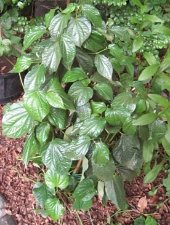On Friday, Saturday and Sunday June 18th and 19th and 20th (longest days of the year!) you are welcome visit my garden in Seattle's Montlake neighborhood. Over the years on various occasions I open my garden for touring. (Bonus: this June
five other nearby gardens are also open.)
Visitors can touch and sniff my many aromatic plants, view my books, and buy copies if desired. Books by others, such as Dr. Linda Chalker-Scott, are also available, as is Walt's Organic Fertilizer. Very few plants, such as Trilliums, will be for sale. I am present to chat, sign books, and act the gracious host. The hours are noon until 6:00 p.m. It is in the afternoon only because certain fragrant flowers only release their scents then. You will not believe the sweet perfume pervading the air from the banana shrub, lemon tree, cherry-pie plant, and so on . . .
The garden is of southwest exposure on a steep hillside. It is not wheelchair accesible; it has 52 steps. Trees abound, native and otherwise. You can see how challenging it is to grow sun-loving plants, including vegetables, in much shade. Recycled materials are used often. For example, from the house I've re-used lath to make compost bins, structural lumber for borders and supports, and concrete foundation chunks to make steps. There is a Trex wood-polymer lumber deck. Bamboo canes are used for vine growth and staking, or are cut short and sharp to dissuade cats from using beds as places to defecate. Recycled bicycle inner tubes are used as plant ties. A chimney I knocked down has become brick plant bed bordering, along with "native" stones sifted from the soil.
Some of the 15 native trees and shrubs include a dominating white pine (under which socializing occurs), red cedar, Douglas fir, dogwood, hazel, tall and low Oregon grape, mock orange (in bloom), and salal. Other than trees and shrubs that were there to begin with, I have acquired and planted mostly
fragrant and edible plants, in an ecclectic fashion. It is informal, organic, and charming. There is no lawn. If you love formality and straight lines you may hate this garden. It will also look strange and unnatural because over 350 plants will be
labeled --there are so many unfamiliar and rare kinds, that labels are needed for visitors.
This year, new features include a display of
edible houseplants including pineapples; a test of various sweet potato cultivars; a black tub planted edible aquatic plants.
There are more than 560 annuals, perennials, vegetables, herbs, vines, flowers, trees, shrubs, and intentional cultivated weeds -- all together. I do not segregate by category. If you come, please do NOT pull weeds. What you may be sure is a weed may be a plant that I am growing for a specific reason. Some of you know that for 23 years I maintained the Weed Garden at Seattle Tilth's urban Agriculture center. For the Tilth newsletter I wrote 100 Weed-of-the-Month articles.
For more information, including directions, please see my website's June Calendar link:
http://www.arthurleej.com/opengarden9i.html Arthur Lee Jacobson





